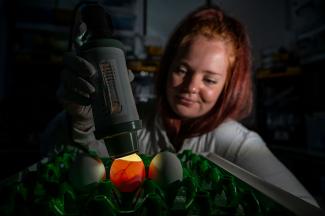Our group
Infectious bursal disease viruses (IBDVs) pose a significant burden on poultry production worldwide, particularly affecting young chickens.
While some IBDV genotypes cause varying degrees of morbidity and mortality, others can spread sub clinically, all associated with severe immunosuppression.
Since IBDV primarily targets the bursa of Fabricius, leading to lymphoid depletion, there is a significant decrease in humoral antibody production, reducing vaccine effectiveness against other viruses and increasing susceptibility to secondary infections.
The bi-segmented RNA and highly resistant nature of the virus to environmental conditions enable its global spread and evolution into various antigenic, pathogenic, and genotypic variants, adding complexity to virus control.
The IBDV group focuses on understanding different IBDV pathotypes - host interactions using both ex vivo and in vivo models and improving control measures against IBDV, especially in young chickens.
Our aims
We aim to investigating the complex interplay of IBDV pathotypes, host cells, bird species and age in the pathogenesis of IBDV.
We also aim to improve control measures against IBDV, especially in young chickens. additionally, investigate the prevalence of immunosuppressive viruses in wild bird populations.
Our research
IBDV poses a significant threat to poultry production worldwide due to its highly immunosuppressive nature, particularly in young chicks, as it targets immature B cells resulting in either permanent or transient immune suppression depending on virus pathotypes and age of infection. This reduces responses to other vaccines and increases vulnerability to different pathogens.
We aim to investigate the complex interplay of IBDV pathotypes, host cells, species, and age in the pathogenesis of IBDV, using ex vivo and in vivo experimental models.
Achieving continuous and uniform specific immunity in the first few weeks is crucial for controlling the virus in young chickens. However, this is challenging due to the need to protect them during a period of higher bursal susceptibility without interfering with maternally derived antibodies (MDA), which typically protect birds over the first two to three weeks. We aim to improve and test control measures against IBDV, especially in young chickens, and investigate the use IBDV as a vector to deliver immunogenic domains of avian viral diseases.
The bi-segmented RNA nature and high resistance of the virus to environmental conditions facilitate its global spread and evolution into diverse antigenic, pathogenic, and genotypic variants, thereby adding complexity to virus control efforts. IBDV primarily affects young chickens clinically, but it can also infect turkeys, ducks, guinea fowl, ostriches, and wild birds. We aim to investigate the role that wild birds may have in disseminating immunosuppressive viruses.
Our impact
Infections with different pathotype of serotype 1 IBDV are widely distributed in major poultry-producing areas, posing a significant burden on global poultry production. Understanding the complex interplay between bird age and species, virus pathotype, host cell response, prevalence of IBDV, and the role of wild can help in the development of better control strategies for circulating IBDV. These would benefit both the global poultry industry and farmers.


